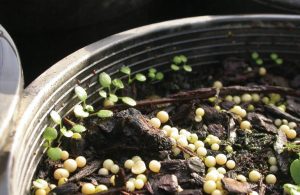STAFF MAY 10, 2017

An Agricultural Research Service (ARS) horticulturist is exploring an alternative method for controlling weeds in greenhouse propagation systems by using steam or hot water to kill weed seeds. The project, conducted under the auspices of a Horticultural Research Institute (HRI) grant and co-funded by the Floriculture and Nursery Research Initiative, is headed by Dr. James Altland.
Altland and his colleagues at ARS in Wooster, Ohio, are documenting the critical temperature and exposure time needed for killing weed seeds with hot water or steam. Weed control in propagation is difficult because it primarily occurs in greenhouses or other covered structures where herbicides are neither labeled nor safe for use. Reuse of plastic propagation trays and containers exacerbates the weed problem. Seeds of many weeds, most notably bittercress (Cardamine flexuosa) and creeping woodsorrel (Oxalis corniculata), stick to plastic containers and trays and are reintroduced into the production system when these containers and trays are reused.
Heat from steam or hot water kills weed seeds. There is an abundance of research on the use of soil solarization to reduce weed seed populations and other pests in soil. Soil solarization, however, is a slow process that involves covering the ground with plastic to heat soil over several days or weeks. Research on soil solarization has established thermal killing temperatures over the range of 40° to 70° C with exposure times of hours to days. Use of hot water or steam to kill weed seed would ideally use higher temperatures for shorter periods of time (seconds or minutes).
Large shipping containers can be converted to steam-treat recycled plastic containers for both weed and disease control.
There is also evidence from some nursery producers that heat or steam provides effective weed control. In Oregon, some nurseries have adopted the Grower Assisted Inspection Program (GAIP) to prevent the spread of the pathogen Phytophthora ramorum. Part of this program includes the use of hot water for killing P. ramorum on reused plastic by dipping it in a water tank at 80° C for 15 minutes. While this control point was intended to prevent the spread of P. ramorum, it has also proved very effective in reducing bittercress populations.
Currently, there is no published information on how high the temperature or how long the exposure time must be to provide 100 percent control of weeds common in greenhouse propagation. The most cited publication is over 60 years old and suggests that “most weed seeds” are killed with temperatures of 70° to 80° C when exposed for 30 minutes. However, the same authors indicate that a few resistant weed seeds require 90° to 100° C.
So far, Altland’s research has found that creeping woodsorrel required exposure to 90° C for at least 5 minutes for 100 percent control. Bittercress was completely controlled with 90° C water at just 1 minute.
Altland’s research is updating an old tool with specific information on which temperatures and exposure times can be used to eliminate weed seeds between successive crops in propagation.